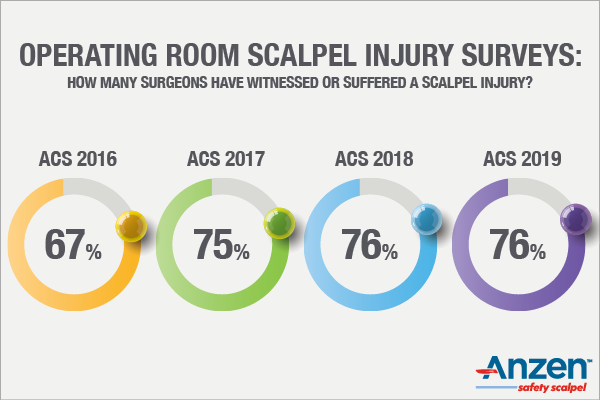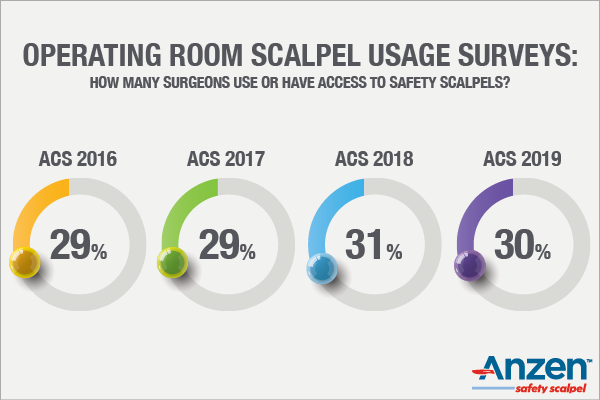Dissecting Safety Scalpel Trends 2016–2019, Part 2: Surveying Surgeons
August 15, 2019Surgeons tell us scalpel-related injury rates in the OR are high, yet their awareness and usage rates of a viable solution—scalpels with sharps safety indications—are low. What is blocking the adoption of safety scalpels…and how is MediPurpose striving to reverse these trends?
In case you missed it, earlier this month, we published “Dissecting Safety Trends 2016–2019, Part 1: Surveying Surgical Technologists,” which used data from surveys we conducted at national healthcare conferences where we were exhibitors. It also provided some detailed reasons for how and why we conduct those surveys—but the key reason is we’re trying to launch the “ideal safety scalpel,” and engaging with end users is a crucial part of our process.
Now it is time to share how surgeons at 2016–19 American College of Surgeons’ conferences responded to the same questions we asked surgical technologists. Although we weren’t surprised at the results, we are concerned surgeons are reporting virtually identical trends for safety scalpel experiences, awareness and usage as surgical technologists…which is not a good thing. But then again, this is exactly why we are hopeful that our Anzen safety scalpel will help reverse those trends!
“…surgeons are reporting virtually identical trends for safety with safety scalpel experiences, awareness and usage as surgical technologists…which is not a good thing.”
Experience with Scalpel Injuries: A Problem That’s Getting Worse
We first asked surgeons questions designed to help us better understand the frequency for which they’ve witnessed or suffered from a scalpel injury in the operating room.

Nearly 73% of surgical techs reported being parties to scalpel injuries. Although it’s close to the most recent rates for surgeons, the unfortunate reality is the rates are rising for surgeons.
Awareness of Safety Scalpels: Rates Stay Flat (and Relatively Low)
Next, we asked surgeons questions designed to help us better understand their awareness of safety scalpels as alternatives to traditional scalpels.

We weren’t able to collect enough information from surgeons to provide sound analysis for 2018 and 2019, but we do know that an average 74% of surgical techs reported awareness of safety scalpels, which is much higher than surgeons.
Usage of Safety Scalpels: Rates Also Stay Flat (and Relatively Low)
Finally, we asked surgeons questions designed to help us better understand their usage of safety scalpels in the OR.

Final Analysis: We Must Continue to Work Towards Giving Surgeons a Reason to Champion an Ideal Safety Scalpel
Making sweeping changes in any industry is a formidable challenge, and even more so in the medical and healthcare sectors. However, we are certain that in order for surgeons to finally put down their traditional scalpels and designate safety scalpels as their preferred standard in the OR, new and innovative devices that meet “ideal” expectations must be introduced. We believe this because there is a growing body of supporting evidence.
“…in order for surgeons to finally put down their traditional scalpels and designate safety scalpels as their preferred standard in the OR, new and innovative devices that meet “ideal” expectations must be introduced.”
First, an Outpatient Surgery report from this year provided two compelling reasons for surgeons’ low usage rates:
- Surgeons refuse to use safety scalpels: When given the option (which has increased an estimated 27% since 2014), surgeons will use safety scalpels approximately 44% of the time.
- Surgeons would use safety scalpels if they found a suitable replacement. The report speculates an inability to give surgeons a preferred device is roughly 36% of the problem.
Additionally, through our own research, we also know that end users are interested in adopting safety scalpels but are not willing to settle for anything less than an ideal device that delivers all the benefits of a safety scalpel but performs like a traditional scalpel. Our ASCA 2016 survey showed 76% of respondents stated they would not use a safety scalpel if:
- It was inconvenient to expose or retract the blade
- The safety components obstructed the line of sight
“…end users are interested in adopting safety scalpels but are not willing to settle for anything less than a device that delivers all the benefits of a safety scalpel but performs like a traditional scalpel.”
These are simple concepts to express, but challenging to actually design and validate, because it is impossible to create an ideal solution that will satisfy every surgeon. However, we are committed to coming as close as possible, and this means delivering a safety scalpel that provides:
- The same weight, balance and sharpness as a traditional scalpel
- A safety shield that does not obstruct line of sight
- Blade cartridges that are safe and easy to remove
- An easy-to-operate safety mechanism that can single-handledly (with either hand) expose or conceal the blade without having to looking at the scalpel
If you would like to learn more about evaluating Anzen™ safety scalpels at your facility, please contact us and/or request samples.


